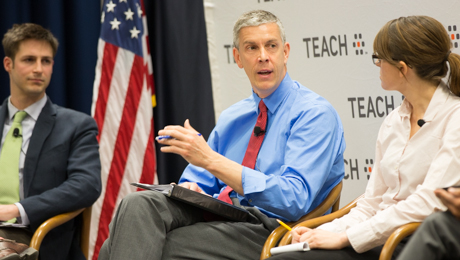By Brittney Dunkins
Department of Education Secretary Arne Duncan put out a call to action urging undergraduates to join a new class of top-notch teachers at a panel discussion held at the George Washington University’s Marvin Center on Monday.
Mr. Duncan joined GW Graduate School of Education and Human Development Dean Michael Feuer, D.C. Hispanic Heritage Youth Awards Teacher of the Year Jen Bado-Aleman, GSEHD graduate student Kate Gaskill, D.C. Teacher of the Year Bill Day and Education Department Ambassador Joiselle Cunningham for the dialogue on the growing need for highly qualified teachers.
“This is a chance to start a movement and bring in the next generation of teachers,” Mr. Duncan said.
The discussion, titled “Why Teach?” was hosted by GSEHD and TEACH, a teacher recruitment organization funded in partnership by State Farm, Microsoft and the U.S. Department of Education.
Mr. Duncan urged students to consider the profession and become “nation builders.” He said that as 3 million baby boomers begin to retire in the next decade, an influx of 1 million new teachers will be necessary to fill the gaps left by an aging workforce.
“Great teachers matter at any time, but they matter explicitly now,” Mr. Duncan added.
The panelists agreed that great teachers are necessary for the success of the nation, not only because American students need to be able to compete globally and restore the national workforce, but also because an ill-equipped education system is a roadblock to social and economic equality.
STEM occupations are predicted to increase to 9 million jobs between 2012 and 2022, and according to the Bureau of Labor Statistics, approximately 120,000 new jobs opening in the U.S. will require a bachelor’s degree in computer science.
“The jobs my students are going to be competing for don’t even exist yet,” said Mr. Day, a math teacher at Two Rivers Charter School in Northeast D.C. “We need people with cutting-edge knowledge in the classroom to support them.”
Dr. Feuer highlighted the role that higher education institutions play in changing the conversation, what Ms. Gaskill called the “just a teacher” narrative, which can discourage high-achieving students from pursuing teaching.
“Our view at GW is that the world is changing, and we need to prepare our teachers to face those challenges,” Dr. Feuer said, pointing to the recent Share Fair, which brought more than 3,500 students and teachers together to GW to learn about STEM-focused experiential education tools.
Ms. Bado-Aleman added that teaching should be focused on critical thinking, student discourse and helping students “make meaning” out of the facts they are learning.
The dearth of black and Latino teachers was also a source of concern among the panelists. According to TEACH statistics, 40 percent of students but only 20 percent of teachers identify as black or Latino.
Ms. Gaskill advised teachers to get into the classroom early and learn the culture and preferences of students.
“Teachers learn best from other teachers,” Ms. Gaskill said. “How we train our teachers determines how we retain our teachers.”
The panelists also tackled the question of low compensation in the field, another deterrent for graduates entering the workforce.
Ms. Cunningham said that often teachers need to be creative if they would like to earn more money, by taking on jobs as grant writers for their schools or pursuing entrepreneurial interests, for example, but she said that the best reward is knowing that students are learning.
“There is payment in teaching,” Ms. Cunningham said. “I don’t want to minimize the issue of compensation, but seeing students succeed, that is something I bring home as a teacher."
Mr. Duncan added that as a “social justice” issue, teaching has shown positive trends, and high school graduation rates have risen. Despite these increases, he emphasized the importance of moving more quickly as a country to support students.
“If we are serious about closing achievement gaps, we need to first close opportunity gaps,” Mr. Duncan said. “The only way to do that is through great teachers.”


